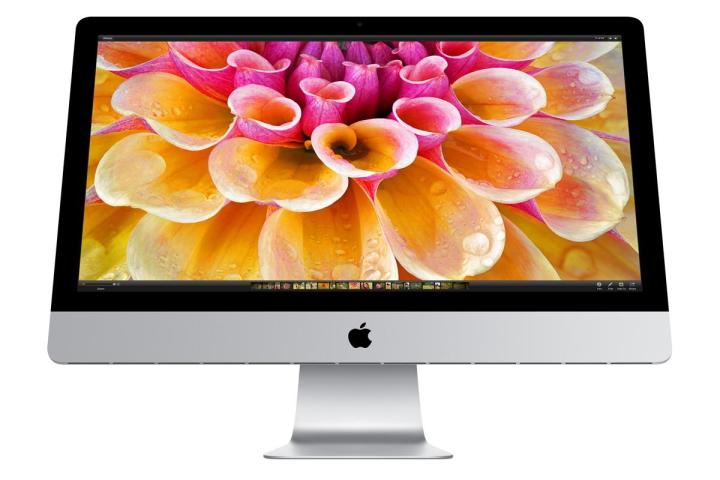
Apple products are notorious for being expensive, so the company deserves credit for releasing a cheaper version of its iMac all in one desktop computer. Prior to yesterday, the entry-level price for an iMac was $1,299. After yesterday’s surprise addition to the company’s iMac family, that number got sliced by $200, to $1,099.
Naturally, that comes with some sacrifices. The iMac still sports an Intel Core i5 processor, but it runs at a much slower clock speed compared to the $1,299 model (1.4GHz versus 2.7GHz). The RAM count is the same (8GB), but a teardown reveals that the RAM in the $1,099 iMac can’t be upgraded. The GPU also got bumped down from Intel Iris Pro graphics, to Intel HD Graphics 5000. The 1080p 21.5-inch display remains constant.
We’re not upset at Apple for the fact that the specs on the $1,099 iMac are weaker than those on the $1,299 version. Any reasonable and pragmatic consumer will come to the conclusion that cheaper usually means “not as good as more expensive stuff.”
However, what we do have issue with is the choices that Apple made with respect to the components found in the $1,099 iMac. In short, if the company made some different decisions on how it equipped the latest iMac, it would’ve resulted in a machine that’s much more well-rounded and capable, while likely carrying a similar price tag — if not the same exact one.
The biggest issue we have with the $1,099 iMac lies in the CPU that Apple decided to stuff it with. When we look around Apple’s entire ecosystem of Mac laptop and desktop hardware, we notice one thing in particular. In all instances, none of the company’s traditional computing hardware includes any Intel Core i3 processors. They’re all of the Core i5 or Core i7 variety.
That is not to say that there’s something wrong with those CPUs. Intel’s Core i5 and i7 chips are generally very powerful. However, part of Apple’s objective in the case of the $1,099 iMac was to release a relatively budget-priced system that can also handle deliver a level of performance that is up to Apple’s standards. If that’s the case, Apple should have replaced the low-power 1.4 GHz Intel Core i5-4260U CPU with the Core i3-4310.
The Intel Core i3-4130 CPU is clocked 2GHz higher than the Core i5-4260U. Perhaps most importantly it is also significantly cheaper than the CPU that Apple (likely) included with the $1,099 iMac. Intel lists the tray price, or the price offered to OEMs (as defined by eHow), at $315 for the Intel Core i5-4260U. Meanwhile, the Intel Core i3-4130’s tray price is $117; almost $200 cheaper. Yes, the Core i5-4260U is much more energy efficient than the i3-4130 (TDPs of 15 watts versus 54 watts, respectively), but this is the iMac. Battery life is not a concern, since this is a desktop.
It’s worth noting that Apple’s spec sheet doesn’t definitively state that the new iMac is powered by the Core i5-4260U CPU. However, based on this Intel document, the Core i5-4260U matches the Turbo Boost clock found in the new iMac, as well as its integrated Intel graphics processor. We think that this is a safe bet.
Anyway, Apple could have taken that savings of $198, and used it to improve one of the $1,099’s two glaring weak points: the GPU, or storage.
Let’s say that the 500GB 5,400 rpm mechanical hard drive in this iMac costs Apple $50 a pop. Apple could have taken that cash, added on the $198 in savings it would have gained by going with an Intel Core i3-4130 processor, and equipped the $1,099 iMac with the Samsung 840 EVO, a 500GB SSD with read/write times of 540/520MBps, respectively.
This would have kept the iMac’s storage count constant, while replacing the mechanical hard drive with something lightning-fast by comparison. On top of that, it would have allowed Apple to keep the budget iMac’s price at $1,099, considering that this SSD costs $256 from Newegg right now. Plus, the Core i3-4130 is a CPU that can certainly hold its own, and then some. This isn’t like comparing a Core i7 to an Atom processor.
Alternatively, Apple could have also invested that $198 in a dedicated graphics card. What about something based on the Nvidia GeForce GTX 750Ti, whose MSRP is roughly $150 (but is a card that can be found for significantly less). There is also Nvidia’s 800M series of laptop GPUs for the taking. Apple’s entire lineup of iMacs are still running on Nvidia’s 700M line, but that’s a whole other story.
By making the decision to go with a cheaper, but still very capable Core i3 CPU, Apple could have used the money it saved in that area, and invested it elsewhere. If the company made some more sensible decisions, it would have ended up releasing a much more balanced iMac, while maintaining the relatively wallet-friendly price tag. That would have been a win-win for both Apple, and consumers as well.
Editors' Recommendations
- The biggest threat to the MacBook this year might come from Apple itself
- Why I went with the MacBook Pro over the Mac Studio
- 6 upcoming products that will make 2024 a huge year for Apple
- My hopes for a new iMac Pro have been dashed — for now
- Apple 16-inch MacBook Pro: don’t make a mistake you’ll regret


